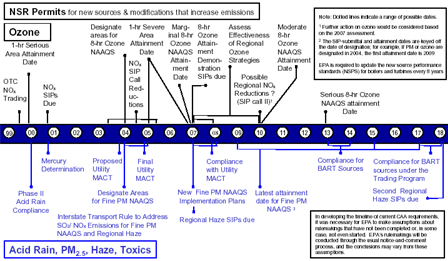Clear Skies
Clear Skies in the District of Columbia
Highlights of Clear Skies in the District of Columbia
- District of Columbia emissions of NOx remain unchanged in 2020 due to Clear Skies. Because there are no coal-fired units in the District of Columbia, EPA projects no emissions of SO2 or mercury.
- The health benefits in the District of Columbia would total $360 million annually ($66 million under the alternative estimate) and include approximately 50 fewer premature deaths (30 under the alternative estimate).
- In addition, the District of Columbia would receive environmental benefits including improved visibility and reduced nitrogen loading in waterways.
- Clear Skies does not significantly impact electricity prices. With or without Clear Skies, electricity prices in the electricity supply region that includes the District of Columbia are expected remain near or below 2000 prices.

Clear Skies: An Innovative Approach to Improving Human Health and the Environment
Why Clear Skies?
- Air quality has improved, but serious concerns persist
- District of Columbia's citizens suffer ill effects from air pollution, including asthma attacks and premature death
- Electricity generation sector remains a major emissions source
- Very cost-effective to control the power sector, relative to other sources
- Sources are concerned about upcoming complex and burdensome regulations
Advantages of the Clear Skies Approach
- Guarantees significant nationwide emissions reductions - beginning years before full implementation
- Delivers dramatic progress towards achievement of critical health and environmental goals
- Uses proven, market-based flexible approach with incentives
for innovation
- Recognizes environmental needs as well as industry constraints, allowing industry to better manage its operations and finances while lowering risks to the public
- Sources are projected to install pollution controls to enable continued reliance on coal
- Increases certainty across the board for industry, regulators, and consumers
Under Current Clean Air Act Power Plants Would Face a Complex Set of Requirements
For a larger image, click here.Clear Skies Sets a Firm Timeline for Emission Reductions
| The existing Title IV SO2 cap-and-trade program provides an incentive and a mechanism to begin reductions upon enactment of Clear Skies years before regulatory action under the current Act. |
2004: The NOx SIP call (summertime NOx cap in 19 Eastern States + D.C.)
2008: Clear Skies NOx Phase I (2.1 million ton annual cap assigned to two Zones with trading programs)
2010:
- Clear Skies Hg Phase I (26 ton annual cap with a national trading program)
- SO2 Phase I (4.5 million ton annual cap with a national trading program)
2018:
- Clear Skies NOx Phase II (1.7 million ton annual cap assigned to two Zones with trading programs)
- Clear Skies Hg Phase II (15 ton annual cap with a national trading program)
- Clear Skies SO2 Phase II (3.0 million ton annual cap with a national trading program)
Emissions in the District of Columbia under Clear Skies
|
Emissions in the District of Columbia (2020) would be significantly reduced from 2000 levels:
There are no coal-fired units in the District of Columbia and EPA projects no emissions of SO2 or mercury in DC |
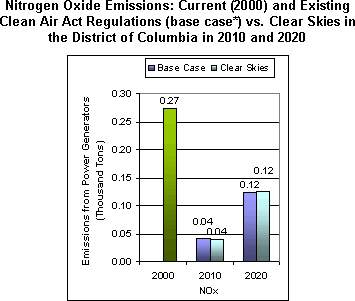
Note: The base case using IPM includes Title IV, the NOx SIP Call, NSR settlements, and state-specific caps in CT, MA, MO, NC, NH, TX, and WI. It does not include mercury MACT in 2007 or any other potential future regulations to implement the current air quality standards or other parts of the Clean Air Act. Base case emissions in 2020 will likely be lower due to state and federal regulatory actions that have not yet been promulgated.
Emission Reductions under Clear Skies
| Emissions in the District of Columbia and surrounding states would decrease considerably. These emission reductions would make it much easier for the District of Columbia to comply with the national air quality standards. |

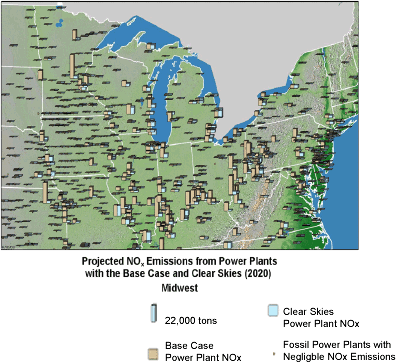
Note: The base case in IPM includes Title IV, the NOx SIP Call, NSR settlements, and state-specific caps in CT, MA, MO, NC, NH, TX, and WI. It does not include mercury MACT in 2007 or any other potential future regulations to implement the current ambient air quality standards or other part of the Clean Air Act. Base case emissions in 2020 will likely be lower due to state and federal regulatory actions that have not yet been promulgated. Emissions projected for new units in 2020 are not reflected.
Clear Skies Environmental Benefits in the District of Columbia

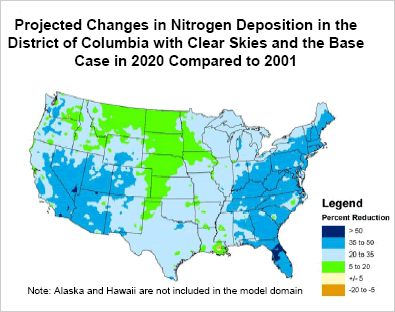
In comparison to existing programs,
- Visibility would improve perceptibly in the District of Columbia.
- The value of improved visibility for District of Columbia residents who visit National Parks and Wilderness areas nationwide would be $11 million each year by 2020.
- Sulfur deposition, a primary cause of acid rain, would decrease
by 30-60%.
- Nitrogen deposition to the Chesapeake Bay watershed would be reduced by up to 20% beyond what is expected under the Base Case.
- Chesapeake Bay States, including NY, VA, MD, PA, DE, WV and DC, recently agreed to incorporate the nitrogen reductions resulting from Clear Skies legislation as part of their overall plan to reduce nutrient loading to the Bay.
- Mercury deposition would decrease by 5-15% across much of the state and up to 30% in some areas.*
* These results are based on modeling the Clear Skies mercury cap without triggering the safety valve.
Electricity Prices in the District of Columbia under Clear Skies
|
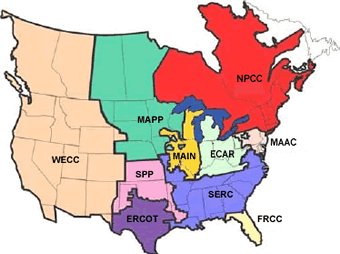
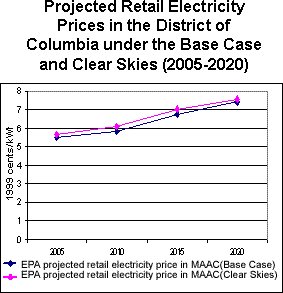

| In 2000, the average retail electricity price in the District of Columbia was approximately 7.5 cents/kWh, which was above the average national retail price of approximately 6.7 cents/kWh. |
Note: The base case using IPM includes Title IV, the NOx SIP Call, NSR settlements, and state-specific caps in CT, MA, MO, NC, NH, TX, and WI. It does not include mercury MACT in 2007 or any other potential future regulations to implement the current ambient air quality standards or other parts of the Clean Air Act. Base case emissions in 2020 will likely be lower due to state and federal regulatory actions that have not yet been promulgated.
Costs and Benefits in the District of Columbia under Clear Skies
Benefits Outweigh the Costs
Clear Skies....
|
- In the District of Columbia, Clear Skies is projected to cost approximately $13 million annually by 2020 while providing health benefits totaling approximately $360 million annually.
- The increases in production costs under Clear Skies represent
only a small percentage of total retail electricity sales revenue
in the District of Columbia.
- Retail electricity sales revenue in the District of Columbia was almost $0.8 billion in 2000.
- Adjusting these sales revenues by the same growth rate used for the modeling of costs would result in revenues of $1.2 billion annually in 2020.
- Nationwide, the projected annual costs of Clear Skies (in $1999)
are $4.3 billion in 2010 and $6.3 billion in 2020; the nationwide
benefits of Clear Skies are expected to be over $113 billion annually
by 2020.
- An alternate estimate projects annual health benefits totaling $23 billion.
Note: Costs include capital costs, fuel, and other operation and maintenance costs (both fixed and variable) associated with the achievement of the emissions caps in the legislation (for example, the installation and operation of pollution controls). These state-level production costs are estimates; they do not account for the costs associated with the transfer of electricity across regions, nor the costs or savings that could be associated with allowance movement between sources.
Notes on EPA's Analysis
- The information presented in this analysis reflects EPA's modeling
of the Clear Skies Act of 2003.
- EPA has updated this information to reflect modifications:
- Changes included in the Clear Skies Act of 2003.
- Revisions to the Base Case to reflect newly promulgated rules at the state and federal level since the initial analysis was undertaken.
- The Clear Skies modeling results presented include the safety valve feature
- EPA has updated this information to reflect modifications:
- This analysis compares new programs to a Base Case (Existing Control Programs), which is typical when calculating costs and benefits of Agency rulemakings.
- The Base Case reflects implementation of current control programs
only:
- Does not include yet-to-be developed regulations such as those to implement the National Ambient Air Quality Standards.
- The EPA Base Case for power sector modeling includes:
- Title IV, the NOx SIP Call, NSR settlements, and state-specific caps in Connecticut, Massachusetts, Missouri, New Hampshire, North Carolina, Texas, and Wisconsin finalized before March 2003.
- For air quality modeling, the Base Case also includes federal and state control programs, as well as the Tier II, Heavy Duty Diesel, and Nonroad Diesel rules.
- Clear Skies in the District of Columbia 2002 (PDF 342KB)

|
State information based on EPA's modeling of the Clear Skies Act of 2002 is presented here for archival reasons. |

